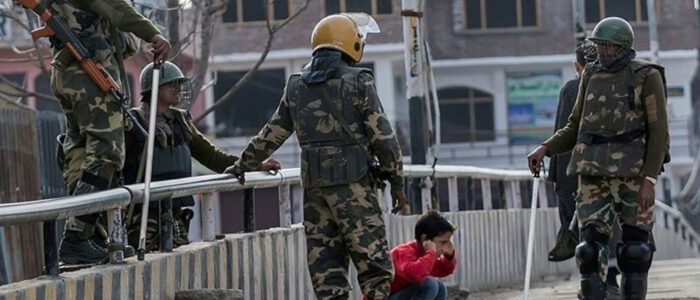Blood-curdling screams and unnerving noises are being heard late at night in South Kashmir. Residents maintain that these distressful sounds are coordinated actions by Indian-occupying forces to terrorise and subdue residents as a part of a long legacy of psychological warfare in the region. Psychological warfare refers to the intentional manipulation of human psychology and emotions to coerce target populations into acquiescence.
The Indian military has been conducting psychological warfare since the early days of the Kashmir liberation movement. This includes alarming and haunting noises emanating from villages late at night and rumoured ghost and jinn sightings. Kashmiris, who grew up in the 1990s, when the armed revolt against Indian forces was at its peak, report Indian soldiers breaking into their homes late at night to damage their property or create a disturbance. Such tactics constitute a deliberate strategy to make Kashmiris feel unsafe in their homes and communities. A climate of fear dampens morale and discourages residents from leaving their homes, including for political assembly. Such a widespread inducement of fear also weakens people’s links with Kashmiri land and territory, disrupting vital linkages with the landscape, which remains a significant obstacle to Indian occupation.
The discomforting noises being heard in Kashmir are said to exploit local folklore on “raantas”. These are mythical creatures, witches with dishevelled hair capable of producing terrifying reverberations. “Raantas” are sometimes lovingly invoked by elders to discourage children from roaming in the cold winter nights to protect them from falling sick. The ongoing Indian occupation is even impacting cultural stories, and Kashmiri’s relationships with their childhood tales are taking on new militarised meanings.
Similar tactics were used during the Vietnam war. The United States (US) military broadcasted terrifying sounds to dissuade the National Liberation Front soldiers. The collage of sounds was designed to tap into Vietnamese beliefs that those not buried at home will roam in a state of distress in the afterlife. The uncomfortable mix of voices, music, and sounds was intended to encourage Vietnamese soldiers to abandon their posts and return home.
The continual use of PSYOP in Kashmir has widespread consequences. Fear, intimidation, and unpredictability have become the defining features of everyday life. It is estimated that more than 60% of the civilian population in Indian-occupied Kashmir suffers from PTSD, depression, or anxiety.
In 2017, there were widespread accounts of attacks on Kashmiri women throughout the valley. Several women were knocked unconscious by unknown assailants to find their braids cut upon regaining consciousness. This created another wave of fear, women were terrified of leaving home, and many girls even stopped attending school. Local vigilante groups were formed to protect one’s neighbourhood from so-called braid choppers leading to further paranoia and animosity. Besides, social fragmentation is already a notable feature of everyday life in the valley. Many are accused of being informants for the Indian military or armed groups, and a general atmosphere of mistrust and suspicion permeates.
Other examples of psychological warfare in Kashmir include military humanitarianism or “heart warfare” to win the hearts and minds of selective communities. Also prominent is the public display of brutal force, particularly against Kashmiri men, midnight raids to arouse fear and anxiety, enforced disappearances, humiliating treatment at frequent checkpoints, and marking and maiming Kashmiri bodies through the use of pellet guns.
Existing structures of violence set in place by the Indian occupying forces work alongside targeted psychological warfare interventions, and in fact, each is imbricated in the other. While proponents of psychological warfare argue that PSYOP (psychological operations) can reduce the loss of life, they are always almost used alongside more overt forms of violence, not in lieu of them.
The continual use of PSYOP in Kashmir has widespread consequences. Fear, intimidation, and unpredictability have become the defining features of everyday life. It is estimated that more than 60% of the civilian population in Indian-occupied Kashmir suffers from PTSD, depression, or anxiety. According to a 2015 report by Médecins Sans Frontières India, over 11% of adults in the Kashmir Valley are taking benzodiazepines. Addiction to drugs such as heroin is also on the rise. While it is speculated that young Kashmiris, particularly men, turn to drugs to cope with the day-to-day uncertainty of living in a conflict zone, the Indian army has also been alleged to supply narcotics to Kashmiri youth. The effects of the “longue durée” of occupation and violence on the public psyche require a nuanced rendering.
Psychological warfare remains a controversial military strategy and has the potential to escape detection largely. As little or no physical devastation is left behind, psychological warfare does not fit into familiar frames of war and is difficult to prosecute under international law. The US military openly hires PSYOP soldiers, and most militaries in the world, including that of India, utilise such tactics. Due to a lack of transparent journalism and ever-increasing curbs on Kashmiri journalists, accounts of psychological warfare in the region remain notably absent from mainstream news reportage. Attention to these dimensions of the occupation is essential to understand the true extent of the violence at play and its lasting legacies.
Earlier this year, Pakistan and India reaffirmed the 2003 ceasefire across the Line of Control (LoC), the de-facto border that divides Kashmir amongst the two countries. The ceasefire was welcomed, given the loss of life on both sides of the LoC. While analysts have lauded the move, Kashmiri demands for de-militarisation and sovereignty remain unmet. It remains to be seen whether positive bilateral relations between Pakistan and India would lead to tangible improvements in people’s everyday lives in the former princely state.
